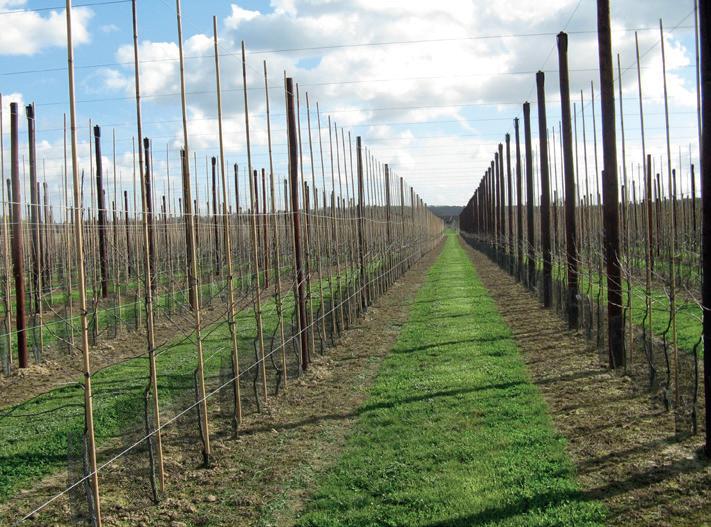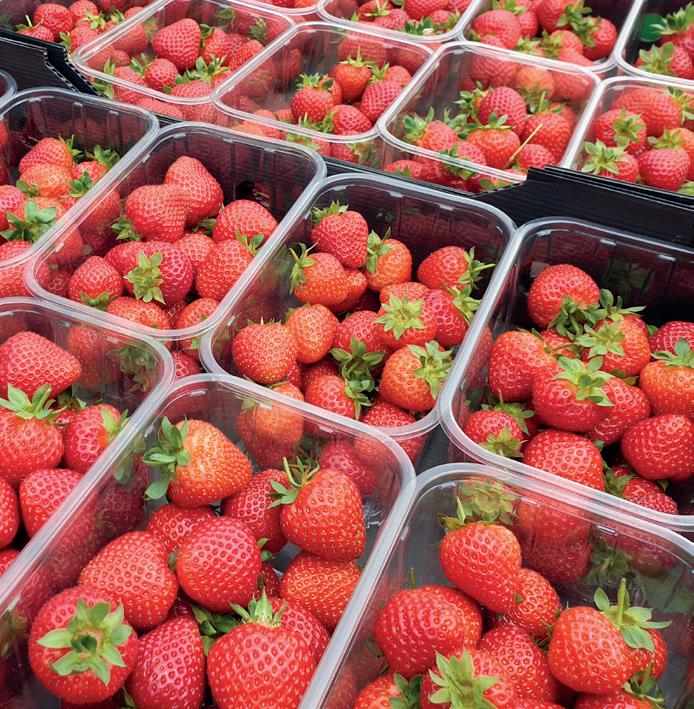
6 minute read
New research talent emerging from the Collaborative Training Partnership for Fruit Crop Research programme
The Collaborative Training Partnership for Fruit Crop Research (CTPfFCR) was instigated by lead partner Berry Gardens Growers Ltd in collaboration with NIAB at East Malling, to help to develop a new generation of fruit crop researchers, to fill the ever-expanding void of young talent coming into the horticulture industry. Funded by the Biotechnology and Biological Sciences Research Council (BBSRC) along with industry partners AHDB, Berry Gardens Growers Ltd, Marks and Spencer, the National Association of Cider Makers, WORLDWIDE Fruit Ltd and the Worshipful Company of Fruiterers, the programme aims to deliver a high-quality training programme for doctoral students, delivering independent, highly-employable scientists in strategically important research and development areas.
The first cohort of students commenced the programme in 2017 and consecutive intakes continued annually each autumn until 2021, so that 40 researchers will have been trained when the final project is completed in September 2025. The majority of students are working with NIAB at East Malling, with others based at the Universities of Cranfield, Essex, Harper Adams, Lincoln, Nottingham and Reading. Each one is researching a topic of interest selected by the industry partners and, within their four-year training period, the students also have the opportunity to experience the sector first hand by spending time with the CTP’s industry partners in their businesses in order to widen their knowledge of the industry.
Advertisement
Many of the CTP’s research topics are complementing research that is already in progress and the results will be adopted by existing NIAB researchers at East Malling and elsewhere. The projects currently in progress are grouped into the following categories:
• Artificial intelligence and robotics
Artificial intelligence and robotics
Three students at the University of Lincoln have been working on projects to inform robotic research and yield forecasting. Justin Le Louedec, who recently completed his doctorate, has been using novel machine learning techniques to teach cameras installed on robotic pickers to identify the correct colour and shape of fruits to pick. Katherine James is creating images of model strawberry plants, which will be able to be used by plant breeders to improve the phenotypic traits of new varieties so that they are, for example, more suited to robotic strawberry harvesters. Finally, George Onoufriou is using yield profile data collected from previous year’s harvests, alongside the recorded temperatures and light levels, to build yield forecasting models. The combination of data sources in a neural network will allow growers to improve their prediction of yield forecasts for up to three weeks ahead.
• Crop science and production systems
Crop science and production systems
As you might expect with industry selected research projects, there are quite a few underway investigating aspects of plant physiology and improving crop production and fruit quality. Sophie Read at the
• Genetics
• Pest and pathogen ecology
University of Reading has been experimenting with the impact of additional lighting and night-break lighting to extend the UK strawberry production season between November and February under glass (Figure 1). In 2023, she plans to employ vertical growing systems using different light levels identified from her previous research. Nicholas Doddrell, another recent graduate from the programme, has worked at NIAB’s Water Efficient Technologies Centre to understand the effect of increasing photosynthesis efficiency on strawberry yields. Measuring photosynthetic active radiation (PAR), he has found that the middle rows in tunnels have a higher rate of photosynthesis and subsequent yield than the outside rows. He is now considering if plant genetics might be manipulated to increase strawberry photosynthesis.
At the universities of Essex and Reading respectively, Menjie Fan and Winnie Swann are working with Dr Mark Else at East Malling to optimise light recipes to maximise photosynthesis and yields in strawberry. Mengjie is investigating the use of blue light with the intention of boosting yields late in the season whilst Winnie has been using supplementary LED lighting and added CO2 to refine a system for improving yield and fruit quality.
Back at NIAB at East Malling, in a project seeking to improve CO2 uptake by stomata in strawberry crops and increase their yields, William Atkinson is experimenting with light and other environmental cues both to increase stomatal density and stomatal opening. Emily Johnstone at the University of Reading is investigating ways to maximise optimum strawberry fruit size for sale to multiple retailers, by manipulating nitrogen input and strawberry growth.
In raspberry, Ece Moustafa is trying to understand the legacy effect of short-term water stress and its impact on fruit size and quality


(Figure 2). Importantly, Ece is also determining how quickly raspberry plants recover from water stress events, which will be very useful information for growers in the future as our climate becomes warmer.

In tree fruit at East Malling, Haidee Tang is using climatic and imaging data to predict apple fruit ripeness, while Catherine Chapman is investigating the potential of apple trees to sequester carbon below ground. Magdalena Cobo-Medina has been researching apple root architecture, root function and soil management. She has identified zones on the genetic map conferring different traits in the rootstock.
Genetics
Creating new varieties and improving their genetic traits is another important aspect of the programme. Camila Gonzalez at NIAB at East Malling is working with the genetics and breeding teams, using a combination of genetic mapping and gene editing to understand the control of flowering in strawberries, specifically the Junebearer Malling™ Centenary and the everbearer Calypso (Figure 3). By improving our understanding of what controls flowering, we hope to be able to find ways of creating continuous flower and fruit production through the season.
Also at East Malling, Matteo Luberti has recently completed his studies having successfully identified genetic markers that confer resistance to Phytophthora cactorum (the cause of crown rot) in apple and these markers are now available for use in the apple breeding programme. At Reading University, Adam Gregg has been studying the genetics behind to manage some of the major pests and diseases affecting fruit crops.
Laura Martinez at Harper Adams University is studying why the potato aphid, a common pest of strawberry, is not reliably controlled by aphid parasitoids. So far, she has discovered that there is genetic variability in the populations of the pest, but this does not appear to influence the susceptibility of the aphids to parasitoids. On a related theme, Stuart Edwards at the University of Reading is finishing his research into the influence of climate warming on aphid parasitoid/prey interactions. Hayden Tempest at East Malling has been investigating the predation of woolly apple aphid by earwigs using radio tagging whilst Cindayniah Godfrey has been investigating the interactions between woolly apple aphid and apple crops, learning about resistance mechanisms and the pest’s reproductive ability.
Four soft fruit pathology projects are currently in progress. At East Malling, Lauren Farwell (Figure 4) is in the final stages of studying the management and control of Cladosporium, a green/black mould that develops on ripening raspberries. She has found that it only grows on the surface of ripe fruits and not green fruits, that good hygiene is important to reduce infection, and she is now investigating biological control options on the surface of the fruit. The range of pathogenic Phytophthora species causing raspberry root rot appears to be increasing and Eithne Browne has been working at Harper Adams University and East Malling to find out which species are prevalent, and which are the most pathogenic. Samantha Lynn has been identifying strawberry genes that confer resistance to powdery mildew, and it is hoped to adopt these findings in the East Malling Strawberry Breeding Club programme. Finlay Bourquin at NIAB Cambridge is investigating both the resistance and susceptibility of strawberries to Botrytis cinerea, whilst also understanding the virulence of different pathogenic strains.
On tree fruit at East Malling, Chris Cook has recently been awarded his PhD after studying beneficial soil inhabiting organisms, some of which are antagonistic to the fungal organisms causing apple replant disease, while Hamish McLean is investigating potential biological control methods for apple canker (Figure 5). Thomas Heaven has been trying to understand why some populations of Venturia inaequalis (the fungus causing apple scab) have developed resistance to commonly used fungicides and at Cranfield University, Katie Stewart is working on novel methods for controlling apple scab.

Student progress into industry
The success of the CTP programme is not just measured by the output of the scientific results, but also by the employment secured by the students at the end of their studies. Three students, from the first intake in 2017, are already working in fruit research roles spanning academia and industry. Carlota Gonzalez Noguer is now a Quantitative Crop Physiologist with NIAB at East Malling and Raymond Kirk is the Chief Technology Officer of a start-up business, FruitCast, who plan to be offering a crop forecasting service to strawberry growers in the next few years. Lastly, Christina Conroy is employed as a Technical Account Manager at Berry Gardens Growers. The next generation of fruit research scientists has already landed!
Berry Gardens Growers Ltd and NIAB at East Malling are extremely grateful to the Biotechnology and Biological Sciences Research Council (BBSRC), AHDB and partner universities, for providing grant funding for the CTPfFCR programme as well as the industry funding sponsors.









